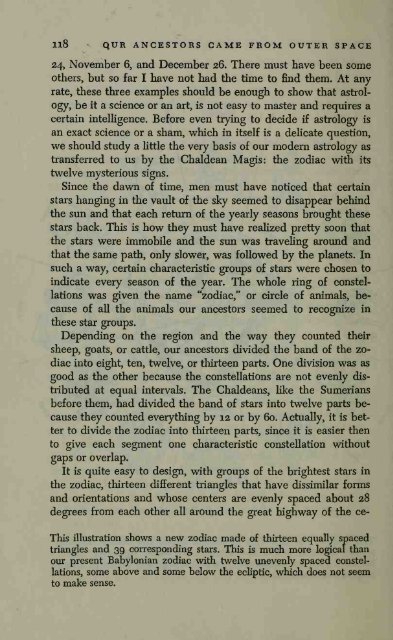Create successful ePaper yourself
Turn your PDF publications into a flip-book with our unique Google optimized e-Paper software.
Il8 - QUR ANCESTORS CAME FROM OUTER SPACE<br />
24, November 6, and December 26. There must have been some<br />
others, but so far I have not had the time to find them. At any<br />
rate, these three examples should be enough to show that astrology,<br />
be it a science or an art, is not easy to master and requires a<br />
certain intelligence. Before even trying to decide if<br />
astrology is<br />
an exact science or a sham, which in itself is a delicate question,<br />
we should study a little the very basis of our modem astrology as<br />
transferred to us by the Chaldean Magis: the zodiac with its<br />
twelve mysterious signs.<br />
Since the dawn of time, men must have noticed that certain<br />
stars hanging in the vault of the sky seemed to disappear behind<br />
the sun and that each return of the yearly seasons brought these<br />
stars back. This is how they must have realized pretty soon that<br />
the stars were immobile and the sim was traveling around and<br />
that the same path, only slower, was followed by the planets. In<br />
such a way, certain characteristic groups of stars were chosen to<br />
indicate every season of the year. The whole ring of constellations<br />
was given the name "zodiac," or circle of animals, because<br />
of all the animals our ancestors seemed to recognize in<br />
these star groups.<br />
Depending on the region and the way they counted their<br />
sheep, goats, or cattle, our ancestors divided the band of the zodiac<br />
into eight, ten, twelve, or thirteen parts. One division was as<br />
good as the other because the constellations are not evenly distributed<br />
at equal intervals. The Chaldeans, like the Sumerians<br />
before them, had divided the band of stars into twelve parts because<br />
they counted everything by 12 or by 60. Actually, it is better<br />
to divide the zodiac into thirteen parts, since it is easier then<br />
to give each segment one characteristic constellation without<br />
gaps or overlap.<br />
It is quite easy to design, with groups of the brightest stars in<br />
the zodiac, thirteen different triangles that have dissimilar forms<br />
and orientations and whose centers are evenly spaced about 28<br />
degrees from each other all around the great highway of the ce-<br />
This illustration shows a new zodiac made of thirteen equally spaced<br />
triangles and 39 corresponding stars. This is much more logical than<br />
our present Babylonian zodiac with twelve vmevenly spaced constellations,<br />
some above and some below the ecliptic, which does not seem<br />
to make sense.

















